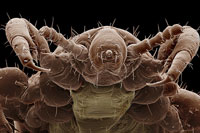Lice Reign in People's Hair
In the last few years, the level of lice infestation in the world has been experiencing a steady growth.

According to the Disinfection Research Institute, Russia is not an exception. In 2008, illness frequency rate in Russia was 201 cases per 100,000 people (among children under 14 years old the rate was 352 cases per 100,000). In Moscow the rate is even higher.
This is understandable since Moscow is a destination for many different categories of people from various countries. Besides, high population density always complicates epidemiological situation. Specialists say that high rate of pediculosis in Moscow is mainly caused by homeless people. The most frequent victims of the illness are children between five and 15 years of age. According to statistics, one third of all children in Russia had at least one occurrence of pediculosis before they turned 18. Medical and social problem of the illness lies in the fact that lice are blood-sucking insects. Lice bites are accompanied by itching sensations, allergic reactions, complications, insomnia, and stress. Socio-psychological consequences of the illness are very important, especially among children.
One of the reasons of growth of pediculosis in the world is economic circumstances. Sanitation measures usually suffer the most under tough economic conditions.
“Children are most susceptive to pediculosis, because when they are in school, their parents weaken control of their personal hygiene,” explained Irina Yaritsina, M.D., head of teenage hygiene department of the Federal Scientific Center of Hygiene.
According to Lyudmila Tsvil, a representative of the Russian Federal Consumer Rights Protection and Human Health Control Service, most occurrences of pediculosis are observed after school breaks, especially summer break, when children go to different countries and regions. Recently, a case of pediculosis was detected in an elite private school visited by children from wealthy families. However, this year the level of illness was brought down.
Specialists are convinced that control is the best measure in a fight against pediculosis. Control measures should be implemented by both educational institutions (systematic examinations) and parents.
There are new anti-lice remedies among regular medications used to treat pediculosis. They are effective not only against lice, but also against their larvae. The new medications are not addictive, allergens-free, and overall have no unpleasant side effects.
The basis for the effective treatment is awareness of the lice life cycle. Health of those who had a contact with a person suffering from pediculosis should be controlled, and every single case requires disinfestations.
Rabkor.ru
Subscribe to Pravda.Ru Telegram channel, Facebook, RSS!




